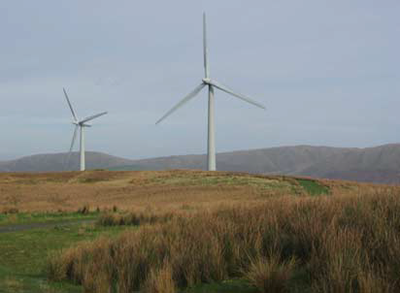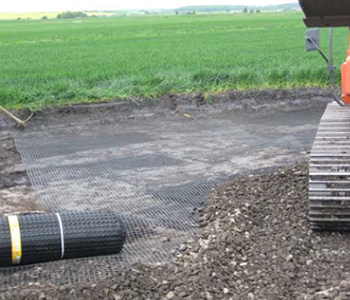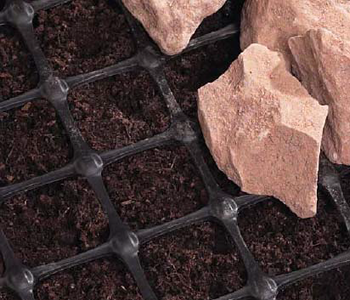 Access to or from construction sites often involves crossing over very weak or variable ground conditions. Thus, before work can begin on site, engineers are often first challenged with the problem of how they actually get to site. Geosynthetic reinforcement solutions are the answer.
Access to or from construction sites often involves crossing over very weak or variable ground conditions. Thus, before work can begin on site, engineers are often first challenged with the problem of how they actually get to site. Geosynthetic reinforcement solutions are the answer.
The Problem
Site access may be required to many different types of projects but in most cases will take the form of an unpaved road. Typical project types may include the construction of a new hotel, supermarket, highway, landfill site, windfarm etc; the list is endless. As supply vehicles need a swift and smooth passage to site to ensure work continues on schedule, it is important that a quality access road be built to withstand the sometimes excessive construction traffic loadings. In general, an unpaved road design is associated with limiting the amount of rutting that will occur on the surface of the road, and is controlled by the thickness of stone used in the construction. The softer the sub-grade then the greater the sub-base thickness required to compensate for the reduction in strength.
The Solution
Rutting of the road is associated with both deformation of the sub-base material and with the underlying subgrade. Thus the influence of a quality reinforcing material on the sub-base performance can help by:
- preventing lateral movement of the sub-base and reducing surface rutting
- increasing sub-base stiffness and reducing vertical stresses in the sub-base
- improving the flexural stiffness of the sub-base and reducing vertical stresses on the subgrade
- reducing shear stresses transmitted from the sub-base to the subgrade
- offering up to a 40% reduction in the unreinforced sub-base thickness required
At Wrekin, we have supplied E’GRID® polypropylene biaxial reinforcement geogrids to numerous projects. In our experience, these materials have demonstrated that when used to reinforce an unpaved road they offer one of the largest possible reductions in the required construction thickness, saving on the amounts of excavation and disposal, as well as imported fill. This is due to E’GRID® bi-axial geogrids having been developed to offer maximum interlock between the adjacent sub-base particles and grid apertures.
 |
 |
Factors that influence this E’GRID® performance include the product having integral junctions, square apertures, and very importantly the fact they have ribs with a rectangular cross section and square edges (applicable to punched and stretched geogrids only); the particular rib shape having been optimised to maximise both rib-edge height and the grid open area in order to ensure positive interlock with the fill.
Recent examples of unpaved access roads on which Wrekin’s team has worked and that have used in excess of 10,000m2 of E’Grid 3030 biaxial geogrids reinforcement include:
- Fenlands ‘Red Tile’ Windfarm, Huntingdon: a design proposal was offered to the Contractor highlighting how reinforcing the unpaved road with E’Grid 3030 could reduce the required sub-base thickness and save on both excavation and imported materials. Based on anticipated traffic loadings and the actual subgrade soil strength an unreinforced sub-base thickness of 603mm was required. By including a layer of E’Grid 3030 at the subbase/subgrade interface the required reinforced sub-base thickness was reduced to 400mm (a 34% saving when compared to the unreinforced design).
- Braes of Doune Windfarm, near Stirling: In excess of 20km of 5.5m wide access roads had to be constructed over peaty silty clay conditions to allow the construction of, and future access to 36 wind turbines. Constructed using graded granular fill and crushed rock, the E’Grid biaxially reinforced roads (some floating) ensured smooth access over some fairly horrific ground conditions. With this project, rather than design the unpaved tracks to carry the entire construction traffic volume, it was decided to design for a lesser number of axle loadings and accept that a degree of maintenance be carried out to the road surface in the form of regrading/filling as and when the surface started to develop wheel rutting in excess of the design criteria.
For additional information on supply and design with these materials or on Wrekin Geosynthetics, please visit the company’s website (www.wrekingeosynthetics.com). For additional information on the E’Grid reinforcement product referenced in this article, see also the E’Grid data from BOSTD Geosynthetics (www.bostd.com) on the geogrids page of GeosIndex (www.geosindex.com).











